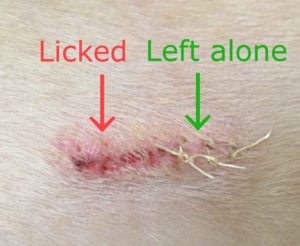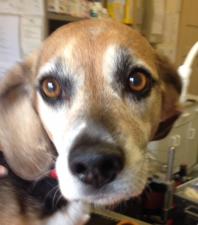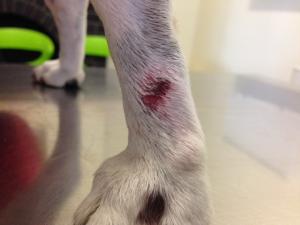Updated November 29, 2020
In these days of the ‘Cone of Shame’ most people know that pets shouldn’t lick their wounds. But there is also a long folk tradition that licking and saliva are good for healing. So where is the truth? Somewhere in the middle, as I will explain.
The first point is that no animal should ever lick a surgical wound. When we suture a wound, it is a completely unnatural, artificial process. Without too much boring detail, this healing is called ‘first intention’ whereas wounds normally heal via ‘second intention’ if left to close by themselves. First intention healing relies on the edges being held together and the absence of infection. Licking cannot help these wounds close faster, and in fact will usually introduce bacteria into the clean wound and create infection.

It is a fact that several substances in saliva have been shown to be antibacterial. The bad news is that they are not especially effective against the common disease-causing bacteria such as Staphylococcus and Pseudomonas.
So what about open wounds which will heal by second intention if left untreated? This is where things get complicated. The first thing every pet owner should know about is the ‘Golden Period’. This is the 6 to 8 hour period after a wound is made in which there has been minimal change or infection. A wound in the golden period can usually be sutured straight away and should heal well if not licked, just like a fresh surgical wound. If we see a wound in this time frame we will suture it without delay, to take advantage of the improved results.

After 6 to 8 hours, wounds will develop an open surface often covered by some sort of ooze or crust. The surface infection will act to slow down the healing process. Theoretically, at this stage, gentle licking for only a few minutes two or three times a day could help by reducing the buildup of contaminated discharge on the surface. Also, a moist wound usually heals faster.
The reality is unfortunately quite different. I have yet to meet a dog or cat who will limit themselves to a brief and scheduled wound clean. Instead, animals who lick wounds tend to do it repeatedly, sometimes for hours at a time. Many owners are unaware of this as, after trying to stop the licking, their pet will sneak off somewhere else or do it overnight. It seems that the urge is too strong.
Frequent licking shuts down the regenerative process completely. Granulation tissue is very fragile and will be rapidly abraded by even the softest tongue. A cat’s tongue can abrade right through intact skin and create a wound. Have you ever tried letting a cat lick you for more than 10 seconds?
Julian, pictured above, did exactly this with his recent cut between his toes. The fresh cut would have been easy to suture, but by the time it was found it had been licked into an infected and abraded sore with no hope of healing. These wounds we treat by having to first debride the non-healing edges back to healthy tissue before suturing the new edges together.

I think the reason people believe licking must have some benefit is quite reasonable. Usually, animal behaviour exists for a reason, often selected for survival advantages in the wild. Surely this urge to lick must come from some beneficial wild origin? The thing is, I agree with this theory. The big difference is that wild animals have so much else going on in their daily life that sitting down to lick a wound for several hours is hard to imagine. They probably do lick for just brief periods and in fact this may be very useful.
Jack’s leg is pictured above. This wound is another example of how harmful licking can be. In this case, Jack started licking a tiny sore, probably linked to his allergic skin disease. The picture shows the wound one week later. It is starting to become one of our most feared skin lesions: the lick granuloma. These lesions are extremely hard to manage because they exist in a classic vicious circle: the wound is infected so it gets licked, and it gets licked because it’s infected, and so on.
Have something to add? Comments (if open) will appear within 24 hours.
By Andrew Spanner BVSc(Hons) MVetStud, a vet in Adelaide, Australia. Meet his team here.
